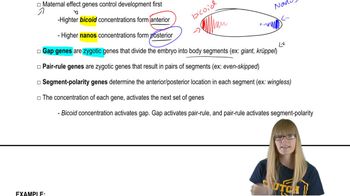The Drosophila homeotic mutation spineless aristapedia (ssᵃ) results in the formation of a miniature tarsal structure (normally part of the leg) on the end of the antenna. What insight is provided by (ssᵃ) concerning the role of genes during determination?
 Verified step by step guidance
Verified step by step guidance
Verified Solution
Key Concepts
Homeotic Genes

Gene Regulation

Morphogenetic Fields
You observe that a particular gene is being transcribed during development. How can you tell whether the expression of this gene is under transcriptional or translational control?
The homeotic mutation Antennapedia causes mutant Drosophila to have legs in place of antennae and is a dominant gain-of-function mutation. What are the properties of such mutations? How does the Antennapedia gene change antennae into legs?
Embryogenesis and oncogenesis (generation of cancer) share a number of features including cell proliferation, apoptosis, cell migration and invasion, formation of new blood vessels, and differential gene activity. Embryonic cells are relatively undifferentiated, and cancer cells appear to be undifferentiated or dedifferentiated. Homeotic gene expression directs early development, and mutant expression leads to loss of the differentiated state or an alternative cell identity. M. T. Lewis [(2000). Breast Can. Res. 2:158–169] suggested that breast cancer may be caused by the altered expression of homeotic genes. When he examined 11 such genes in cancers, 8 were underexpressed while 3 were overexpressed compared with controls. Given what you know about homeotic genes, could they be involved in oncogenesis?
The specification of the anterior–posterior axis in Drosophila embryos is initially controlled by various gene products that are synthesized and stored in the mature egg following oogenesis. Mutations in these genes result in abnormalities of the axis during embryogenesis. These mutations illustrate maternal effect. How do such mutations vary from those produced by organelle heredity? Devise a set of parallel crosses and expected outcomes involving mutant genes that contrast maternal effect and organelle heredity.
